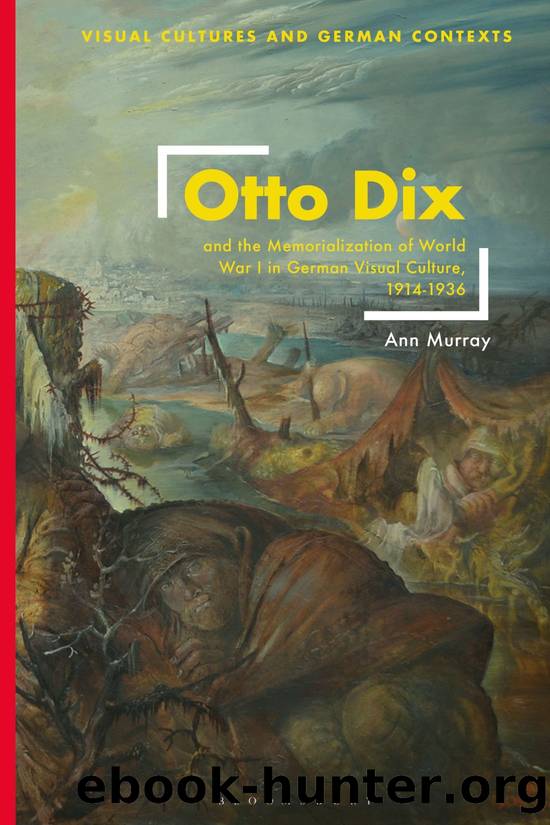Otto Dix and the Memorialization of World War I in German Visual Culture, 1914-1936 by Ann Murray;

Author:Ann Murray;
Language: eng
Format: epub
ISBN: 9781350354647
Publisher: Bloomsbury UK
Published: 2023-08-22T00:00:00+00:00
4
Metropolis as war memorialization
According to the Saxon State Archives, by 1 October 1926, Otto Dix was formally offered the position of Professor of Painting at the Dresden Academy of Arts for a period of seven years, which finally provided him with a stable income.1 Dixâs appointment was publicly announced in the Dresdner Anzeiger on 4 October, which described him as a worthy successor to the deceased Otto Guβmann (whose position he would fill), because of his undisputed position as a leading German artist and doubtless talent, despite his youth.2 No doubt, when Gustav Hartlaubâs travelling Neue Sachlichkeit show reached Dresden in October 1925, it helped establish Dixâs name further in that city prior to its hosting of the biggest international art exhibition in Germany since World War I, the Internationale Kunstausstellung Dresden (International Art Exhibition, Dresden) (June to September 1926), in which he exhibited six works.3 In addition to further exhibitions, Dix also featured in Hans Cürlisâs innovative, insightful series of short films on artists collectively titled Schaffende Hände (Creative Hands) in 1926, which showed him working on several pictures, including Drei Weiber (Three Women) (1926).4
As Dix settled into his professorial role, the German government, headed by the Social Democratic Party (SPD) continued to grapple with the rise of militant politics. Interest in the memory of the war was again harnessed by the tenth-anniversary commemorations of the armistice. The still deeply divided responses to the outcome of the war were registered by the content of the SPDâs widely read satirical magazine, Der Wahre Jacob, for example, which worked to guide Germans away from extremist elements and towards moderate politics, and regularly pointed to the devastation caused by the war, as recalled in an illustration marking the ninth anniversary of the Kaiserâs abdication (and flight) and the proclamation of a republic (Figure 29). The caption reads: âAccording to his announcement, the last Hohenzoller had led the German people towards glorious days. But nothing can be more difficult for a people to endure than such a series of good days.â
Figure 29 Karl Holz, Kurze Geschichte der deutschen Revolution (Short History of the German Revolution), Der Wahre Jacob, 29 October 1927, p. 3.
The voices of anti-extremist, pro-democracy, republican groups were heard, as in, for example, the Reichsbanner Schwarz-Rot-Gold, a mass organization formed in February 1924 against left-wing and right-wing extremism and consisting in good part of democrats and veterans.5 The Reichsbannerâs presence in organized public gatherings helped counter those of militarist elements such as the Stahlhelm. Though somewhat less accessible than publications like Der Wahre Jacob because of its intellectual leanings, Die Weltbühne, continuing its work as a left-wing, explicitly anti-militarist forum, now counted the remarkable Carl von Ossietzky and Kurt Tucholsky, and many more, in frequently and forcefully decrying positive attitudes to war. The journal caused a sensation internationally when from 1925 a number of articles, written by ex-Black (Schwarze) Reichswehr member Carl Mertens, leaked information on the kangaroo courts and summary executions â the Fememorde (Feme Murders) â carried out by
Download
This site does not store any files on its server. We only index and link to content provided by other sites. Please contact the content providers to delete copyright contents if any and email us, we'll remove relevant links or contents immediately.
| Artists' Books | Essays |
| Monographs |
You & Me & Why We Are in Love by Aurelia Alcaïs(2938)
The Four Agreements: A Practical Guide to Personal Freedom (A Toltec Wisdom Book) by Ruiz Don Miguel(2124)
7-14 Days by Noah Waters(1737)
Wall and Piece by Banksy(1463)
Things Are What You Make of Them: Life Advice for Creatives by Adam J. Kurtz(1454)
Hieronymus Bosch by Virginia Pitts Rembert(1311)
The Thibaults by Roger Martin Du Gard(1310)
Post-Impressionism by Nathalia Brodskaya(1289)
The Andy Warhol Diaries by Andy Warhol(1257)
The Notebooks of Leonardo Da Vinci by Da Vinci Leonardo(1251)
Design as Art by Bruno Munari(1239)
The Andy Warhol Diaries by Andy Warhol & Pat Hackett(1223)
Picasso by Gertrude Stein(1217)
Modeling the Head in Clay by Bruno Lucchesi(1204)
Delphi Complete Works of Vincent van Gogh by Vincent van Gogh(1197)
Memory's Wake by Fenech Selina(1189)
Delphi Complete Works of Artemisia Gentileschi (Illustrated) by Artemisia Gentileschi(1159)
William Blake by Burdett Osbert(1075)
Delphi Complete Works of Edgar Degas by Edgar Degas(1057)
